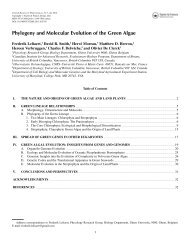Phylogeny and molecular evolution of green algae - Phycology ...
Phylogeny and molecular evolution of green algae - Phycology ...
Phylogeny and molecular evolution of green algae - Phycology ...
You also want an ePaper? Increase the reach of your titles
YUMPU automatically turns print PDFs into web optimized ePapers that Google loves.
20 CHAPTER 2<br />
Introduction<br />
The <strong>green</strong> plant lineage or Viridiplantae represents one <strong>of</strong> three groups <strong>of</strong> photosynthetic eukaryotes<br />
that diverged after enslavement <strong>of</strong> a cyanobacterium to make a primary chloroplast (Rodriguez-<br />
Ezpeleta et al. 2005). Ultrastructural <strong>and</strong> <strong>molecular</strong> studies have identified a major split within the<br />
Viridiplantae giving rise to two lineages, the Chlorophyta <strong>and</strong> the Streptophyta (Pickett-Heaps <strong>and</strong><br />
Marchant 1972, Lewis <strong>and</strong> McCourt 2004). The Streptophyta consists <strong>of</strong> several lineages <strong>of</strong><br />
freshwater <strong>green</strong> <strong>algae</strong> from which l<strong>and</strong> plants evolved approximately 470 million years ago 2 (Karol<br />
et al. 2001, McCourt et al. 2004, Hall <strong>and</strong> Delwiche 2007). Whereas considerable progress has been<br />
made during the past decade in clarifying the relationships among the streptophyte <strong>green</strong> <strong>algae</strong> <strong>and</strong><br />
l<strong>and</strong> plants (Parkinson et al. 1999, Turmel et al. 2003, Turmel et al. 2006, Lemieux et al. 2007, Moore<br />
et al. 2007, Rodriguez-Ezpeleta et al. 2007, Saarela et al. 2007), the phylogeny <strong>and</strong> <strong>evolution</strong>ary<br />
history <strong>of</strong> the Chlorophyta has been more difficult to elucidate.<br />
Members <strong>of</strong> the Chlorophyta are common inhabitants <strong>of</strong> aquatic environments <strong>and</strong> exhibit a<br />
remarkable morphological <strong>and</strong> cytological diversity ranging from the world’s smallest free-living<br />
eukaryote Ostreococcus, over multicellular filaments <strong>and</strong> foliose blades, to highly complex siphonous<br />
life forms. Four classes are recognized within the Chlorophyta: Prasinophyceae, Ulvophyceae,<br />
Trebouxiophyceae <strong>and</strong> Chlorophyceae. The predominantly marine planktonic Prasinophyceae form a<br />
paraphyletic assemblage <strong>of</strong> unicellular organisms from which the Ulvophyceae, Trebouxiophyceae<br />
<strong>and</strong> Chlorophyceae (UTC) are derived (Steinkötter et al. 1994, Fawley et al. 2000, Lopez-Bautista <strong>and</strong><br />
Chapman 2003, Guillou et al. 2004). The latter three classes form a monophyletic group termed UTC<br />
clade but the relationships among them form the basis <strong>of</strong> a longst<strong>and</strong>ing debate (Pröschold <strong>and</strong><br />
Leliaert 2007). All possible relationships between the UTC classes have been hypothesized over the<br />
years, depending on which ultrastructural characters were interpreted or which DNA locus or<br />
phylogenetic analysis method was used (Fig. 1). The unstable relationships exhibited among these<br />
three classes are likely due to a combination <strong>of</strong> their ancient age <strong>and</strong> the short time span over which<br />
they diverged from one another (O'Kelly 2007). The fossil record indicates the presence <strong>of</strong> the classes<br />
in the mid-Neoproterozoic (Butterfield et al. 1994) <strong>and</strong> <strong>molecular</strong> clock estimates situate the UTC<br />
divergence in the early Neoproterozoic (Douzery et al. 2004, Zimmer et al. 2007, Herron et al. 2009).<br />
The UTC lineages occupy distinct <strong>and</strong> widely divergent ecological niches. The Chlorophyceae <strong>and</strong><br />
Trebouxiophyceae are ubiquitous in freshwater <strong>and</strong> soil ecosystems. Furthermore, trebouxiophycean<br />
<strong>algae</strong> are the favored partner in symbiotic relationships with fungi to form lichens. Members <strong>of</strong> the<br />
Ulvophyceae, on the other h<strong>and</strong>, are best known as marine macro<strong>algae</strong> in coastal ecosystems, but<br />
some <strong>of</strong> them live in damp subaerial habitats such as humid soil, rocks, tree bark <strong>and</strong> leaves (Lopez-<br />
Bautista <strong>and</strong> Chapman 2003, Watanabe <strong>and</strong> Nakayama 2007). Having evolved from a marine<br />
prasinophyte ancestor, the UTC lineages have experienced one to several transitions to a freshwater<br />
2 This estimate is based on a plant phylogeny derived from 27 plastid protein-coding genes calibrated with<br />
plant fossils (S<strong>and</strong>erson et al. 2003). Estimates based on phylogenies <strong>of</strong> eukaryotes derived from 75 nuclear<br />
protein coding genes calibrated with vertebrate fossil suggest that vascular plant already diverged from mosses<br />
about 700 mya, which suggest that l<strong>and</strong> plants are at least 700 my old (Heckman et al. 2001; Hedges 2004). A<br />
possible explanations for this huge difference might be the use <strong>of</strong> other calibration points (i.e. plant versus<br />
vertebrate fossils).

















